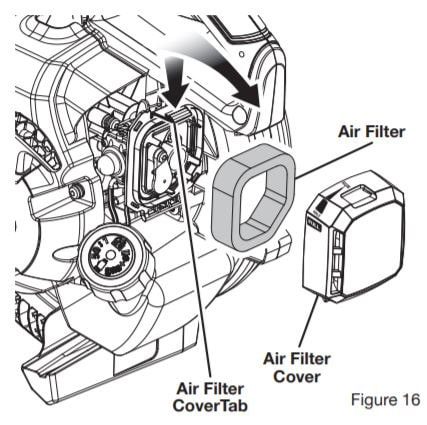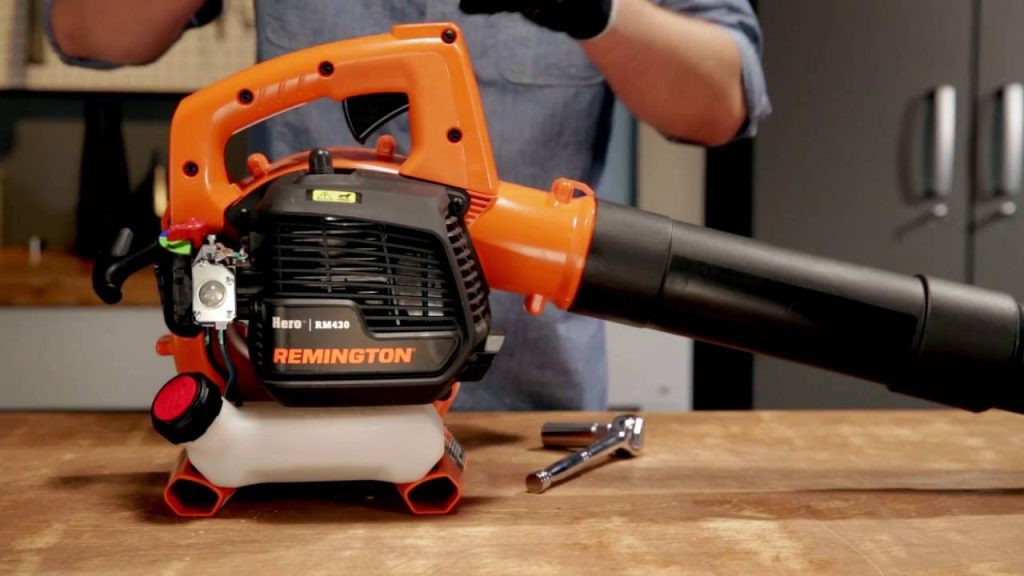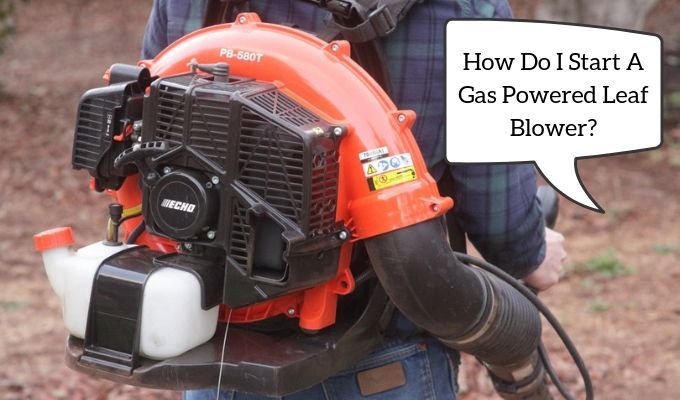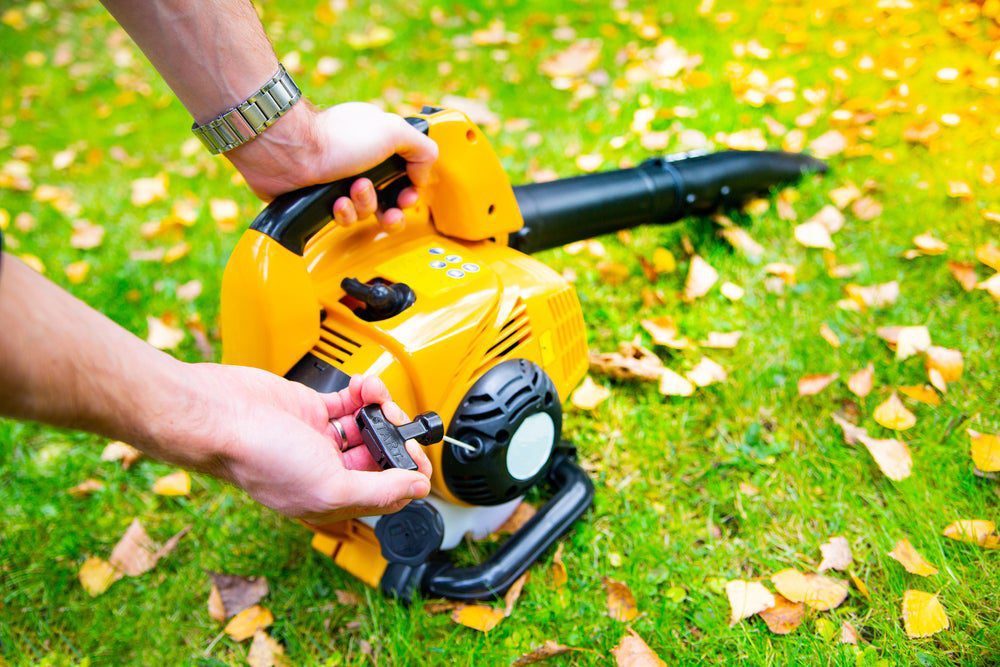Maintaining a gas leaf blower’s engine is essential to keep it running smoothly and efficiently.
From regular fuel and oil checks to cleaning the air filter and spark plug, there are several simple steps we can take to ensure our gas leaf blower stays in top-notch condition.
This article will explore the critical maintenance tasks required for a gas leaf blower’s engine, providing helpful tips and advice.
So, whether you’re a seasoned gardener or a rookie leaf blower enthusiast, join us as we uncover the secrets to keeping your gas leaf blower’s engine humming like a well-tuned symphony.
Regular Cleaning
Regular cleaning is essential to maintain the performance and longevity of your gas leaf blower’s engine. You can keep your engine in top condition for efficient operation by following simple cleaning steps.
Remove Debris from Externals
The first step is to remove any debris from the external components of the engine. Use a soft brush or cloth to gently sweep away any dirt, leaves, or grass clippings that may have accumulated on the surface. Pay special attention to the air intake vents and the cooling fins, as these areas can quickly become clogged, affecting the engine’s performance.
Clean Cooling Fins
The cooling fins play a crucial role in maintaining the appropriate temperature of the engine. Over time, these fins can become coated with dirt and debris, hindering their ability to dissipate heat efficiently. To gently clean the cooling fins, use a small brush or compressed air to remove any buildup. Be careful not to bend or damage the fins, as this can limit their effectiveness.
Inspect and Clean the Muffler
The muffler is responsible for reducing the noise produced by the engine. Over time, it can become clogged with carbon deposits, affecting the engine’s performance. Inspect the muffler regularly and clean it if necessary. You can use a wire brush or a muffler cleaning solution to remove carbon buildup and ensure proper airflow.
Clean and Replace Air Filters
Air filters are crucial in preventing dirt and debris from entering the engine. Regularly inspect the air filters and clean them using compressed air or a soft brush to remove any accumulated debris. If the filters appear damaged or excessively dirty, they must be replaced promptly to maintain optimal engine performance.
Fuel System Maintenance
Proper maintenance of your gas leaf blower’s fuel system ensures reliable and efficient operation. Here are some critical steps to keep in mind.
Use Fresh Fuel
Using fresh fuel is crucial for optimal engine performance and longevity. Stale or contaminated fuel can lead to clogging of the fuel system and poor combustion, resulting in reduced power and potential damage to the engine. Always use fresh, high-quality gasoline with the recommended oil ratio for your leaf blower model.
Drain Fuel at the End of the Season
At the end of the leaf-blowing season, it’s essential to drain the fuel from the tank and the fuel lines. Storing fuel in the engine for extended periods can cause the fuel to break down and leave deposits that can clog the fuel system. To drain the fuel, run the engine until it runs out or use a siphoning tool to remove it manually.
Clean and Replace Fuel Filters
Fuel filters help keep dirt and debris from entering the engine and causing damage. Regularly inspect the fuel filters and clean them according to the manufacturer’s recommendations. If the filters are damaged or excessively dirty, replace them promptly to ensure proper fuel flow and combustion.
Inspect and Clean the Carburetor
The carburetor plays a vital role in the fuel delivery system of your gas leaf blower. Over time, it can become clogged with dirt, debris, or old fuel residue, causing poor engine performance. Inspect the carburetor regularly using a carburetor cleaner or a carburetor cleaning kit. Follow the manufacturer’s instructions and do not damage any delicate components.
Check Fuel Lines for Damage
Inspect the fuel lines for any signs of damage, such as cracks, leaks, or brittleness. Damaged fuel lines can lead to leaks or improper fuel flow, affecting the engine’s performance. If you notice any damage, replace the fuel lines immediately to prevent further issues.
This image is the property of www.leafblowersdirect.com.
Lubrication
Proper lubrication is vital to minimize friction and ensure smooth operation of the engine’s moving parts. Take the following steps to maintain optimal lubrication.
Check and Change Engine Oil
Regularly check the engine oil level to ensure it is at the recommended level. If the oil appears dirty or contaminated, it must be changed promptly. Refer to your leaf blower’s manual for the specific oil type and viscosity the manufacturer recommends. Always use high-quality oil designed for 2-stroke engines to ensure proper lubrication.
Lubricate Moving Parts
Inspect the engine’s moving parts, such as the throttle linkage and the recoil starter, for signs of wear or lack of lubrication. Apply a small amount of lubricating oil to these parts to ensure they move smoothly and avoid excessive friction.
Inspect and Grease Bearings
Bearings are critical components that allow various engine parts to move smoothly. Regularly inspect the bearings for any signs of wear or damage. Apply grease to these areas to ensure proper lubrication and extend the engine’s lifespan.
Spark Plug Maintenance
The spark plug ignites the fuel mixture in the engine’s combustion chamber. It is essential to regularly inspect and maintain the spark plug for optimal engine performance.
Inspect and Replace Spark Plug
Inspect the spark plug regularly for signs of wear, such as a broken electrode or excessive carbon deposits. If the spark plug appears damaged or excessively worn, it must be replaced promptly to ensure a vital spark and efficient combustion.
Check Spark Plug Gap
The spark plug gap refers to the distance between the center and ground electrodes. It’s crucial to check the spark plug gap periodically and adjust it if necessary. Use a feeler gauge to measure the gap, and consult your leaf blower’s manual for the recommended gap specifications.
Clean and Re-gap Spark Plug
A dirty spark plug can lead to poor ignition and engine misfires. Use a small wire brush or a specialized spark plug cleaner to remove any carbon deposits and dirt from the spark plug. After cleaning, re-gap the spark plug if necessary to ensure optimal performance.
This image is the property of i.ytimg.com.
Ignition System
The ignition system generates the spark that ignites the fuel mixture in the combustion chamber. Regular maintenance of the ignition system is crucial for reliable engine operation.
Check Ignition Module
Inspect the ignition module for any damage or wear, such as loose connections or corroded terminals. A faulty ignition module can result in a weak or inconsistent spark. If any issues are detected, consult a professional for repair or replacement.
Inspect the Spark Arrestor Screen
The spark arrestor screen prevents sparks from exiting the muffler and causing fires. Over time, the screen can become obstructed with carbon deposits and debris. Regularly inspect the spark arrestor screen and clean it using a wire brush or a specialized spark arrestor cleaner. Ensure proper airflow through the screen to maintain efficient engine operation.
Clean and Adjust the Ignition Coil
The ignition coil generates the high voltage needed to create a spark. Inspect the ignition coil regularly for any signs of wear or damage. Clean the ignition coil using a soft brush or cloth to remove any dirt or debris hindering its performance. Additionally, if the leaf blower’s engine is experiencing ignition issues, consider adjusting the ignition coil according to the manufacturer’s specifications.
Exhaust System
The exhaust system plays a crucial role in directing exhaust gases away from the engine and reducing noise. Regular exhaust system maintenance ensures efficient operation and compliance with noise regulations.
Inspect and Clean the Exhaust Port
The exhaust port can become coated with carbon deposits over time, restricting the flow of exhaust gases. Regularly inspect and clean the exhaust port using a brush or a specialized exhaust port cleaner. Ensure proper airflow through the port to maintain optimal engine performance.
Check and Replace Exhaust Gaskets
Exhaust gaskets create a tight seal between different components of the exhaust system, preventing leaks and reducing noise. Regularly inspect the exhaust gaskets for signs of damage or deterioration. If any issues are detected, replace the gaskets promptly to maintain the proper functioning of the exhaust system.
Inspect and Replace the Spark Arrestor
The spark arrestor is located at the end of the muffler and prevents sparks from exiting the exhaust system. Over time, the spark arrestor can become clogged with carbon deposits and debris, affecting engine performance. Regularly inspect the spark arrestor and clean or replace it if necessary.
This image is the property of www.alure.com.
Cooling System
The cooling system is responsible for dissipating the heat generated by the engine during operation. Proper cooling system maintenance ensures that the engine remains at the optimal temperature for efficient performance.
Check the Cooling Fan and Housing
Inspect the cooling fan and housing for any signs of damage or obstruction. Ensure that the fan blades rotate freely and no obstructions block the airflow. Clean the fan blades and housing regularly to remove any dirt or debris hindering cooling.
Inspect and Clean Cylinder Fins
The cylinder fins are responsible for dissipating heat from the engine. Over time, they can become coated with dirt and debris, reducing their effectiveness. Regularly inspect the cylinder fins and clean them using compressed air or a soft brush to maintain optimal heat dissipation.
Check Cooling Air Ducts
The cooling air ducts ensure proper airflow through the engine. Regularly inspect the air ducts for any signs of damage or blockage. Clean the air ducts using compressed air or a soft brush to remove accumulated debris and ensure uninterrupted airflow.
Engine Seals and Gaskets
Proper maintenance of engine seals and gaskets ensures a tight seal between different engine components, preventing leaks and maintaining optimal engine performance.
Inspect and Replace Crankshaft Seals
Crankshaft seals prevent oil leaks and maintain the integrity of the engine’s internal components. Regularly inspect the crankshaft seals for any signs of damage or deterioration. If any issues are detected, replace the seals promptly to prevent oil leaks and potential engine damage.
Inspect and Replace the Cylinder Head Gasket
The cylinder head gasket creates a seal between the cylinder head and the engine block, preventing compression loss and coolant leakage. Regularly inspect the cylinder head gasket for signs of damage or wear. If any issues are detected, replace the gasket promptly to ensure a proper seal and prevent engine overheating.
Check and Replace the Carburetor Gasket
The carburetor gasket ensures a tight seal between the carburetor and the engine. Regularly inspect the carburetor gasket for signs of damage or deterioration. If any issues are detected, replace the gasket promptly to prevent air leaks and ensure proper fuel-air mixture delivery.
This image is the property of bettertoolz.com.
Piston and Cylinder Maintenance
Proper maintenance of the piston and cylinder is crucial for efficient engine operation and longevity.
Check Piston Rings
The piston rings ensure a proper seal between the piston and the cylinder walls, preventing compression loss and maintaining optimal engine performance. Regularly inspect the piston rings for signs of wear, damage, or carbon buildup. If any issues are detected, replace the piston rings promptly to ensure a tight seal.
Inspect and Clean the Cylinder
The cylinder is an essential component that houses the piston and facilitates the combustion process. Regularly inspect the cylinder for any wear, scoring, or damage. Clean the cylinder using a soft cloth or specialized cylinder cleaner to remove any carbon deposits or debris that may hinder engine performance.
Check and Replace the Piston
The piston’s condition is crucial for proper combustion and efficient engine operation. Regularly inspect the piston for signs of wear, damage, or scoring. If any issues are detected, replace the piston promptly to ensure optimal engine performance.
Overall Inspection and Tuning
In addition to the specific maintenance tasks mentioned above, performing an overall inspection and tuning is essential to keep your gas leaf blower’s engine running smoothly.
Check for Loose Bolts and Screws
Vibrations during operation can cause bolts and screws to loosen over time. Regularly inspect the engine for loose bolts or screws and tighten them as necessary. This will prevent potential damage and ensure the integrity of engine components.
Inspect and Tighten Vibration Dampeners
Vibration dampeners are crucial in reducing the vibration transmitted to the operator during use. Regularly inspect the vibration dampeners for signs of wear or deterioration. If any issues are detected, replace or tighten the dampeners to ensure comfortable and safe operation.
Examine the Fuel Tank for Leaks
Regularly inspect the fuel tank for any signs of leaks or damage. Fuel leaks can be hazardous and can also negatively impact engine performance. If any leaks are detected, repair or replace the fuel tank promptly to prevent fuel wastage and potential accidents.
Adjust Engine Speed and Performance
Periodically check and adjust the engine speed and performance according to the manufacturer’s recommendations.
This will ensure that the engine operates at optimal RPM and that the power output meets your requirements. Consult the leaf blower’s manual for specific instructions on adjusting the engine speed.
In conclusion, properly maintaining a gas leaf blower’s engine is essential for optimal performance, longevity, and safe operation. Following these maintenance procedures allows you to keep your engine running smoothly and enjoy efficient leaf-blowing sessions for years.
Consider your leaf blower’s manual for specific instructions and prioritize safety when performing maintenance tasks.
This image is the property of empire-s3-production.bobvila.com.








































